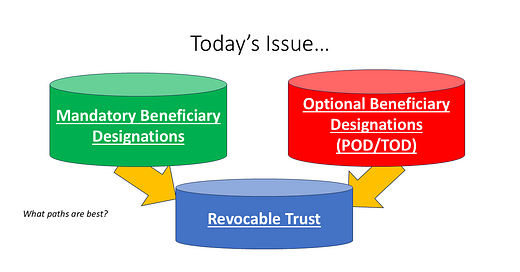A "Better" Approach to Estate Plan Funding, Part 7: Intro to Beneficiary Designations
When to transfer ownership of assets to a revocable trust, versus when to name the trust (or a subtrust thereof) as a beneficiary
Note: While this series is for paid subscribers, I will have the entire course available for a separate one-time download after publishing the last installment. Stay tuned for more.
Table of Contents
Intro
In the last presentation, we discussed differences between joint revocable trusts and individual revocable trusts. Given the vast differences between states, I could not provide concrete recommendations either way, but many of the discussion points therein can help one discuss pros and cons with a client.
But, there is an even more hotly-contested debate in estate plan funding. This debate involves two questions and options:
Should we transfer ownership of assets to a revocable trust during life; or
Should we instead retain ownership of assets, while instead naming the trust as beneficiary, POD designee, or TOD designee?
Hidden in this debate is a third choice - should we retain joint ownership of assets between spouses, as opposed to funding the revocable trust(s)? This third question will be answered next time.
In this presentation, I step out on a limb to give lists (not intended to be all-inclusive) of situations where one option might be preferred over the other.
As a hint, here is the key visual for this video and article:
Video
Keep reading with a 7-day free trial
Subscribe to State of Estates to keep reading this post and get 7 days of free access to the full post archives.





